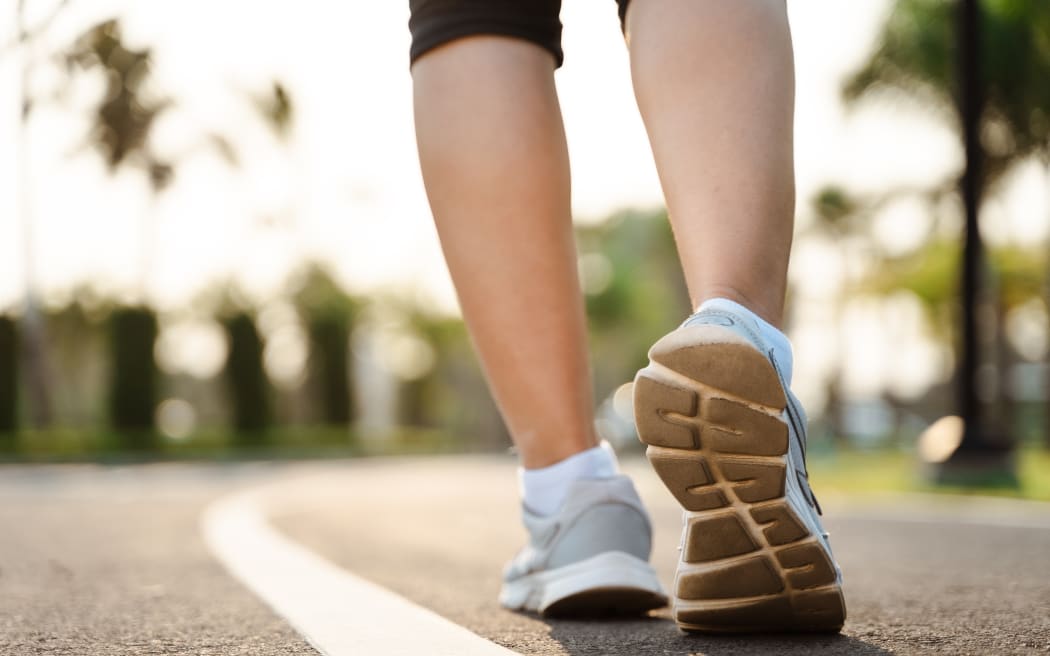One of the slightly bizarre new fitness trends doing the rounds is retro walking. Basically, walking backwards.
Stacey Morrison, host of RNZ’s Healthy or Hoax podcast, laced up her trainers to find out if the rewards of reverse exercise outweigh the risks.
Follow Healthy or Hoax on Apple Podcasts, Spotify, iHeart or wherever you get your podcasts
Why walk backwards?
YouTube experts and fitness gurus suggest walking backwards is a really good way to get fitter faster, to strengthen muscles and even improve brain health. But what does the science tell us?
Professor Winston Byblow, director of the movement neuroscience laboratory, says health scientists are often are looking for ways to help people move better and recover after certain types of injuries or conditions.

Professor Winston Byblow, director of the movement neuroscience laboratory at the University of Auckland Photo: RNZ
"Retro walking is interesting because it is really combining two elements. One is walking, which has well-known benefits. And the other one is that it prevents an additional challenge by demanding more attention. I mean, you can imagine that, if you try walking backwards, the first problem you run into is you can't see where you're going."
Is walking backwards different to walking forwards?
Pablo Ortega Auriol, a research fellow at the Auckland Bioengineering Institute, is an expert in the biomechanics of walking. He says certain aspects of backwards walking, such as how the segments of the body move, look really similar but the actual difference is in the muscle activity.
"Since we have a cognitive load in [walking backwards] our muscles activate more with a little bit of a different timing than when we work forward."

Pablo Ortega Auriol, research fellow at the Auckland Bioengineering Institute Photo: RNZ
Simply put, because you have to think about what you are doing when you walk backwards, your muscles activate more.
While he hasn't seen any long-term studies on retro walking, he says that appears to be what happens in the beginning and it seems that this actually helps to improve balance in certain population.
Retro walking in action
In order to illustrate muscle activation during reverse walking, Stacey hopped on the state-of-the-art treadmill in the movement neuroscience laboratory.
Ortega Auriol points out how when you are walking forwards, the calf muscles, or gastrocnemius, propels you forwards and you do not have to think about it.
"Most of the motor pathways involving walking are present in the spinal cord, not actually in the brain," he says.
"When babies are tested, you just grab them, put them on a table with their feet on a flat surface, and they have, like, a stepping reflex. That's because the brain is not involved. They're not thinking about walking."

Babies have a stepping reflex Photo: africa-studio.com (Olga Yastremska and Leonid Yastremskiy)
But this all changes when you walk backwards.
Stacey turned around on the treadmill, taking careful note of where the handles were and began walking backwards at a much slower pace, about two-thirds of the speed she had been walking forwards.
Initially, she felt very uncoordinated, unsure what do to with her arms and the motion felt a lot more like an awkward march than and smooth walk.
She also felt her thighs were being activated in a different way.
Ortega Auriol said she was no longer pushing with her ankle and the electrical activity of her muscles would look very different if Stacey were hooked up in to an EMG.
"But actually if you record this in a video and then play it backwards, it looks like really similar," he says.
What's the research say about retro-walking?
There has been a lot of research into backwards walking, but the results are quite varied.
Many were looking at test subjects who are either post-stroke or suffering other neurological conditions or knee osteoarthritis. There did appear to be some benefits for these people in a clinical setting.
A very small study of 16 school-age boys showed those who did backwards walking training had better balance at the end of a 12-week program. But it didn't specify whether the control group did any other activity at all.
A third study, this on healthy subjects, found that while there were benefits to backwards walking in a rehab setting, the dangers of instability should be considered before incorporating it into a training program.
Perhaps the key finding came from a 2020 study which said: "Current evidence supporting the benefits of backward walking over forward walking remains inconclusive."

Is walking backwards really the key to fast-forwarding your fitness? Photo: 123rf
Retro-walking recommendations
"There's very little evidence to support it and they're not from particularly well-controlled studies," says Byblow.
"In other words, they look at the benefits accrued with backward walking compared to not doing anything. And something's almost always better than nothing.
"When you compare the weight of evidence for retro walking compared to going for a vigorous forward walk three to five times a week, those studies are absolutely unequivocal.
"The evidence, in favour of that vigorous walking is coming from hundreds of studies with tens of thousands of people, particularly older adults, who just show really remarkable benefits from doing that," he says.
Risks vs rewards
Byblow says there is no harm in backwards walking if you are looking for something to change up your fitness regime. But he warns that there are risks to talking backwards.
Ortego says it's really tricky for older adults who might already have balance problems.
"There have been many reports of them falling and having ugly consequences, like a hip fracture or something like that, which ultimately is a worse outcome than what you had before," he says.

Reverse walking increases cognitive load Photo: 123rf
One of the main rewards from retro-walking is supposed to be general brain health due to the greater cognitive load from walking backwards.
Professor Byblow challenges that assertion.
"If you're interested in walking to preserve cognitive functions, the best thing that you can do is go for a walk every day, 20 to 30 minutes, at the kind of rate that just gets you breathing a little bit heavy," he says.
"That actually has probably one of the best neuro-protective effects of anything we know of. There is no drug that will give you that kind of benefit to your brain. Adding a little bit of cognitive demand by walking backwards doesn't allow you to exercise as vigorously to produce those effects. And it comes with all of the challenges in terms of the risk of falls."
So, backwards walking is not exactly a hoax, but do not expect reverse exercise to maximise your results.
There is a wealth of scientific evidence that walking forwards is really good for you, and there's less chance of falling and breaking a hip.

